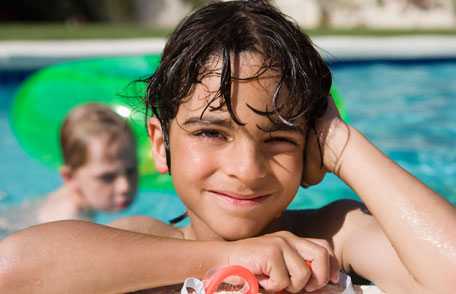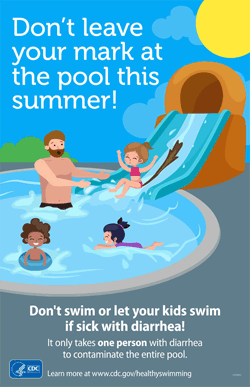Healthy and Safe Swimming Week 2017

Pools, waterparks, hot tubs/spas, and water playgrounds are great places to have fun, be active, or just relax. May 22 – 28, 2017, is Healthy and Safe Swimming Week. Learn how to stay healthy and safe when in the water this summer!
Swimming is one of the most popular sports activities in the United States, and just 2.5 hours of water-based (or other forms of) physical activity per week has health benefits no matter your age. As with any physical activity, we maximize the health benefits when we each do our part to minimize the risk of illness and injury.
Diarrhea and Swimming Don’t Mix!
The pool is the last place you should be if you are sick with diarrhea. Most swimming-related outbreaks reported to CDC are caused by diarrheal germs like Crypto (short for Cryptosporidium), Giardia, Shigella, norovirus, and E. coli O157:H7. Crypto outbreaks linked to swimming are increasing and are particularly hard to control, because the germ is not easily killed by chlorine.

Don’t swim or let your kids swim if sick with diarrhea! See more posters on healthy and safe swimming on our health promotion materials page.

Learn how to stay healthy and safe while swimming.
That’s why it’s so important not to swim or let your kids swim if sick with diarrhea. Just one diarrheal incident in the water can release millions of germs. If someone swallows a mouthful of the water, it can cause diarrhea lasting up to 3 weeks.
We all share the water we swim in. Swimmers should take simple steps to protect themselves, their friends, and family from germs that cause diarrhea when heading to the pool this summer:
- Don’t swim and don’t let children swim when sick with diarrhea.
- Don’t swallow the water.
- Shower before you get in the water. Rinsing off in the shower for just 1 minute helps get rid of any germs that may be on your body.
- Take kids on bathroom breaks.
- Check diapers, and change them in a bathroom or diaper-changing area–not poolside–to keep germs away from the pool.
Prevent Injury
Staying safe in and around the water is important, too. Don’t forget sun safety and drowning prevention. Drowning is a leading cause of unintentional injury death among children 1–14 years old. In fact, drowning kills more young children aged 1-4 years than anything else except birth defects.
Of drowning victims who survive and are treated in emergency rooms, more than half are hospitalized or transferred for further care. They often experience brain damage, which can cause memory problems, learning disabilities, or permanent loss of basic functioning (or permanent vegetative state). Swimmers can prevent drowning by learning swimming skills like floating, by wearing life vests, and by swimming under the supervision of parents, caregivers, or lifeguards who know cardiopulmonary resuscitation (CPR).
Remember: Think Healthy. Swim Healthy. Be Healthy! Follow CDC’s Steps of Healthy Swimming to protect yourself and loved ones from germs, chemicals, or injury when swimming or playing in the water this summer.
FREE Healthy and Safe Swimming Resources
- CDC Healthy Swimming brochures (available in English and en Español)
- CDC Pool Chemical Safety posters (each available in English and en Español)
- Water Quality & Health Council (WQHC)’s Healthy Pools page
- Page last reviewed: May 19, 2017
- Page last updated: May 19, 2017
- Content source:
- National Center for Emerging and Zoonotic Infectious Diseases, Division of Foodborne, Waterborne, and Environmental Diseases
- Page maintained by: Office of the Associate Director for Communication, Digital Media Branch, Division of Public Affairs




 ShareCompartir
ShareCompartir